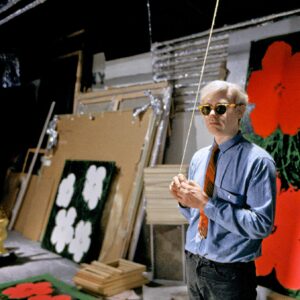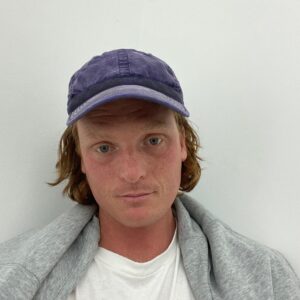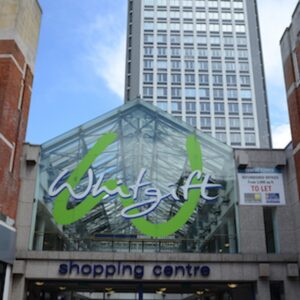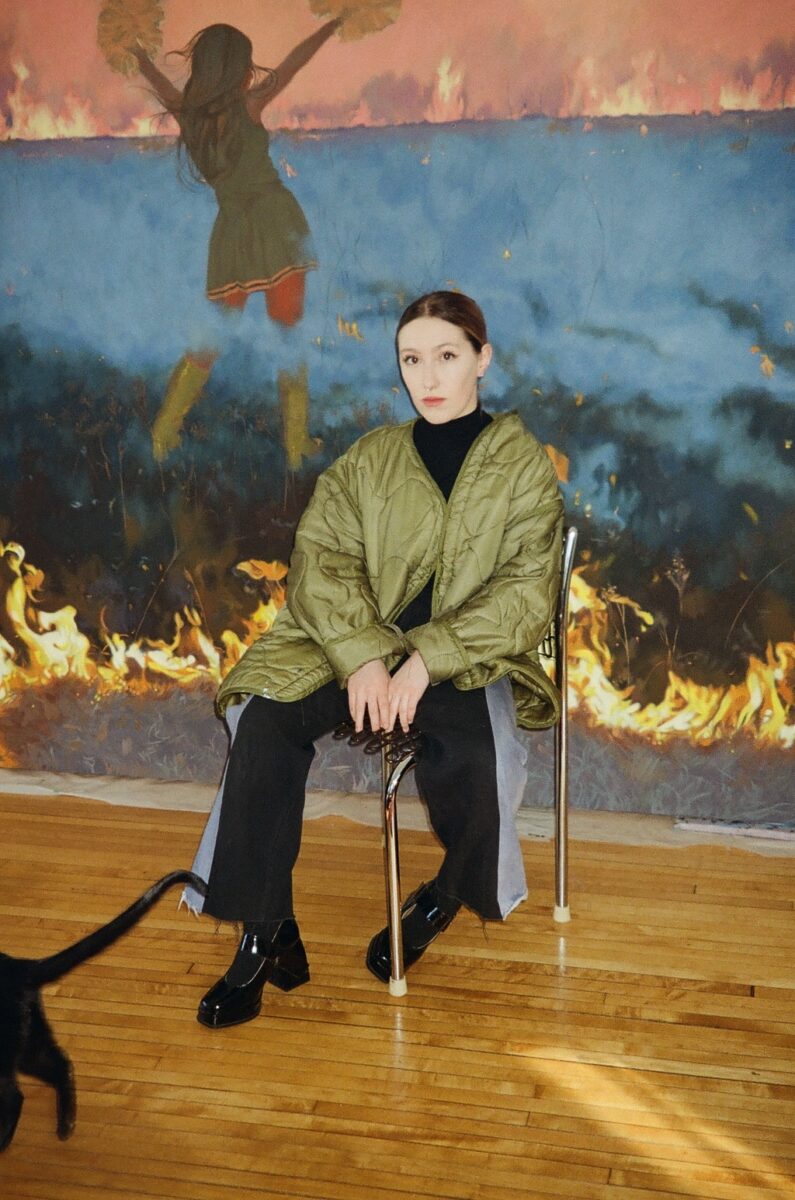
Emma Beatrez is an interdisciplinary artist whose practice explores psychoanalysis, human belief systems, and contemporary culture. Drawing on influences ranging from psychological theories of the symbolic and the real, Beatrez blends personal, social, and universal narratives across sculpture, painting, and immersive installations. Her work engages the body, ritual, and the recontextualization of materials to create new meanings and provoke deep viewer reflection on togetherness and ritual.
Beatrez’s painting practice often incorporates bold and intimate imagery, including human figures, abstracted faces, and elements of pop culture, which reflect her exploration of identity, transformation, and the emotional landscape. Her use of fragmented or exaggerated forms suggests a tension between internal and external experiences, while the inclusion of organic elements, like fire or surreal interpretations of anatomy, ties into themes of growth, vulnerability, and regeneration. The frequent blending of textures, such as rhinestones and leather, alongside more traditional painting methods, evokes a sense of duality between the sensual and the harsh. Through these decisions, Beatrez’s work engages with the complexities of human emotion, offering an evocative commentary on both personal and collective identities, and the constant push and pull between connection and isolation.
Beatrez earned her BFA in painting from North Dakota State University and her MFA in Interdisciplinary Visual Studies from the Minneapolis College of Art and Design. Beyond her personal practice, Beatrez is an active contributor to the art community. She co-founded Night Club Gallery in St. Paul, Minnesota, with artist Lee Noble. This artist-run space fosters collaboration and provides emerging artists with a platform for showcasing their work, reinforcing Beatrez’s commitment to creative dialogue and artistic experimentation.
Beatrez lives and works in Minneapolis, Minnesota. She has exhibited in a variety of art spaces, including HAIR+NAILS Gallery, Nemeth Art Center, and Weisman Art Museum in Minnasota; Anthony Gallery and LVL3 in Chicago; Guts Gallery in London; and Fierman Gallery, Nathalie Karg Gallery, and Swivel Gallery in New York.
Through her innovative use of sensory stimuli and psychoanalytic theory, Beatrez crafts environments where meaning constantly shifts, inviting viewers to explore the interplay between the real and the symbolic and reflect on how symbols evolve over time and shape the collective cultural landscape.
Beatrez’s latest exhibition, Polyester, will open at HAIR+NAILS Gallery in New York on March 8th, 2025, and run through April 26th, 2025.
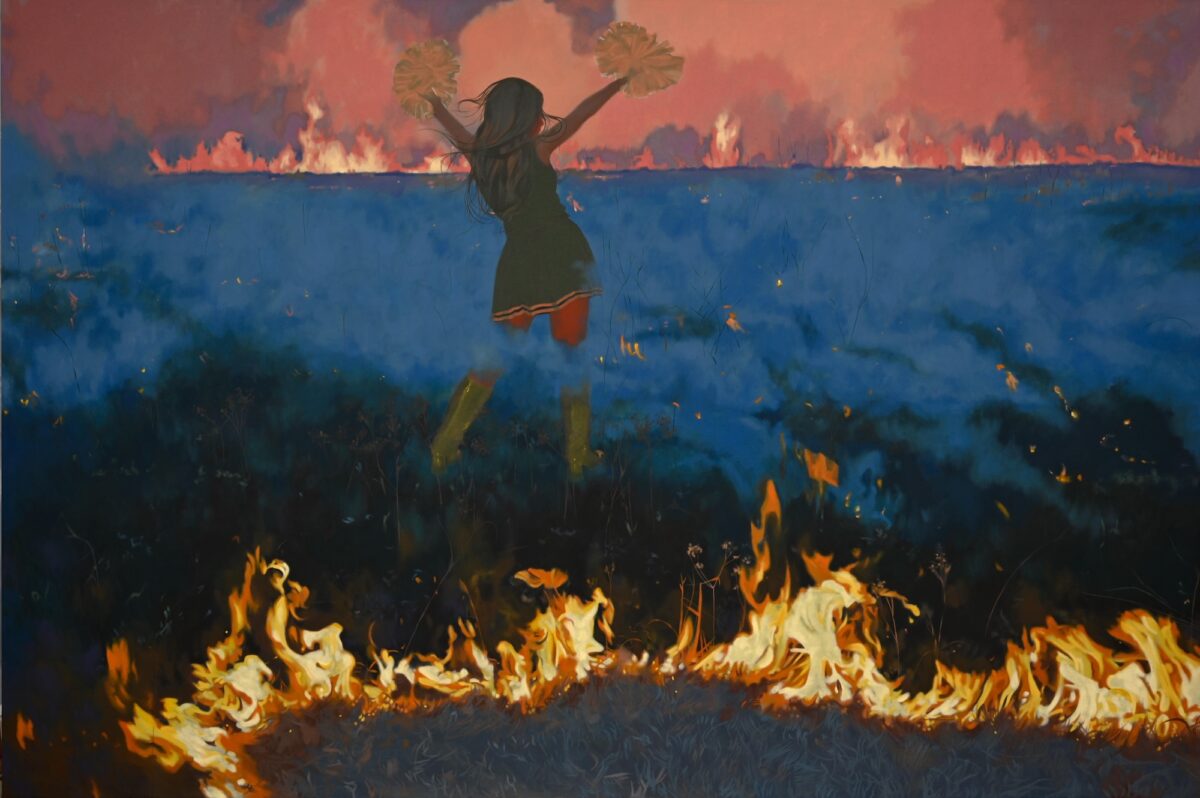
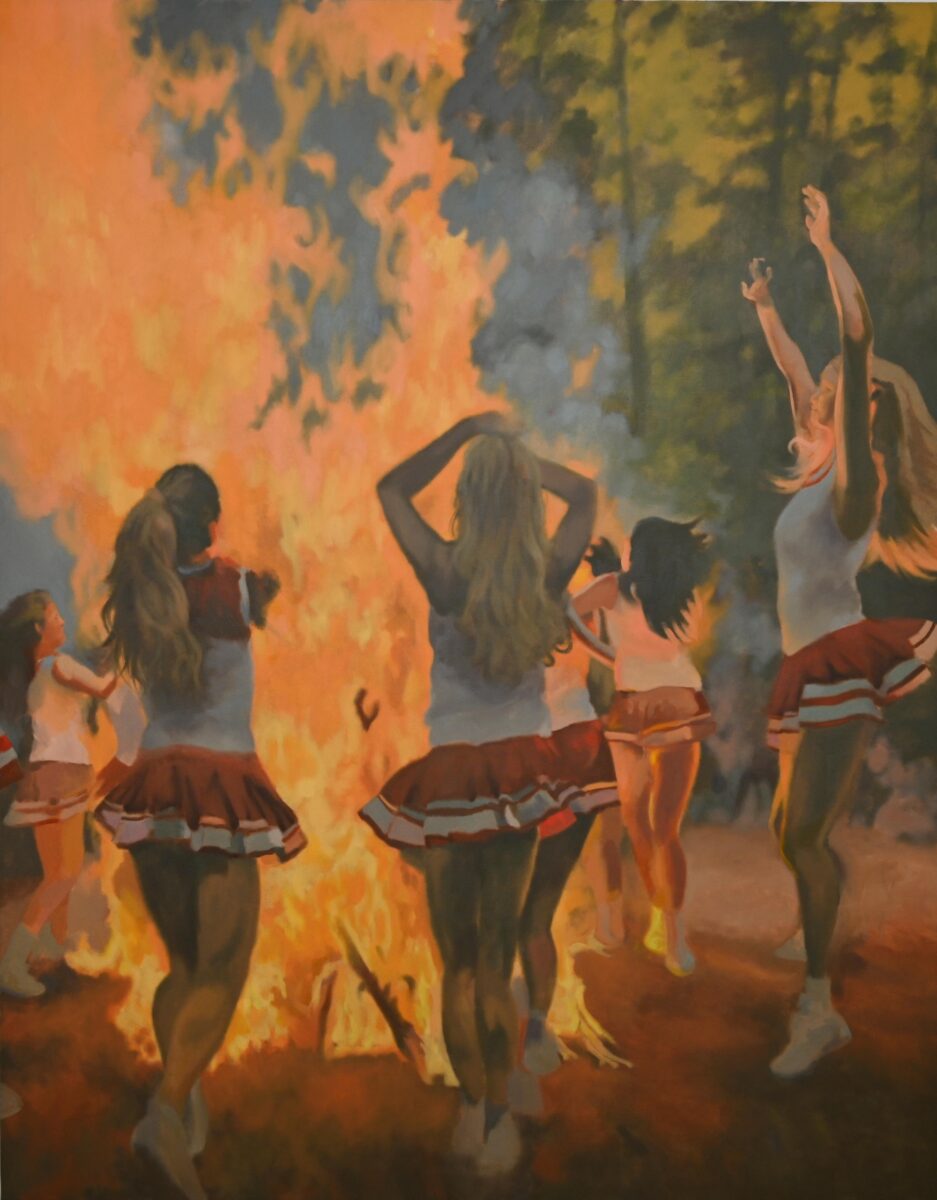
Phillip Edward Spradley: Can you share the inspiration behind the imagery in your latest exhibition, Polyester? Where were these images sourced from and were you ever a cheerleader?
Emma Beatrez: I wasn’t ever a cheerleader, I was more of a figure skater but those two are completely unrelated except for the rink being next door to the football field. I initially came across this cheerleader photo in a Minneapolis library archive I was digging through. The photo was this epic, very militant, cold formation of nameless cheerleaders right before the big act and I was like, okay, there’s something really interesting here that I never really expected.
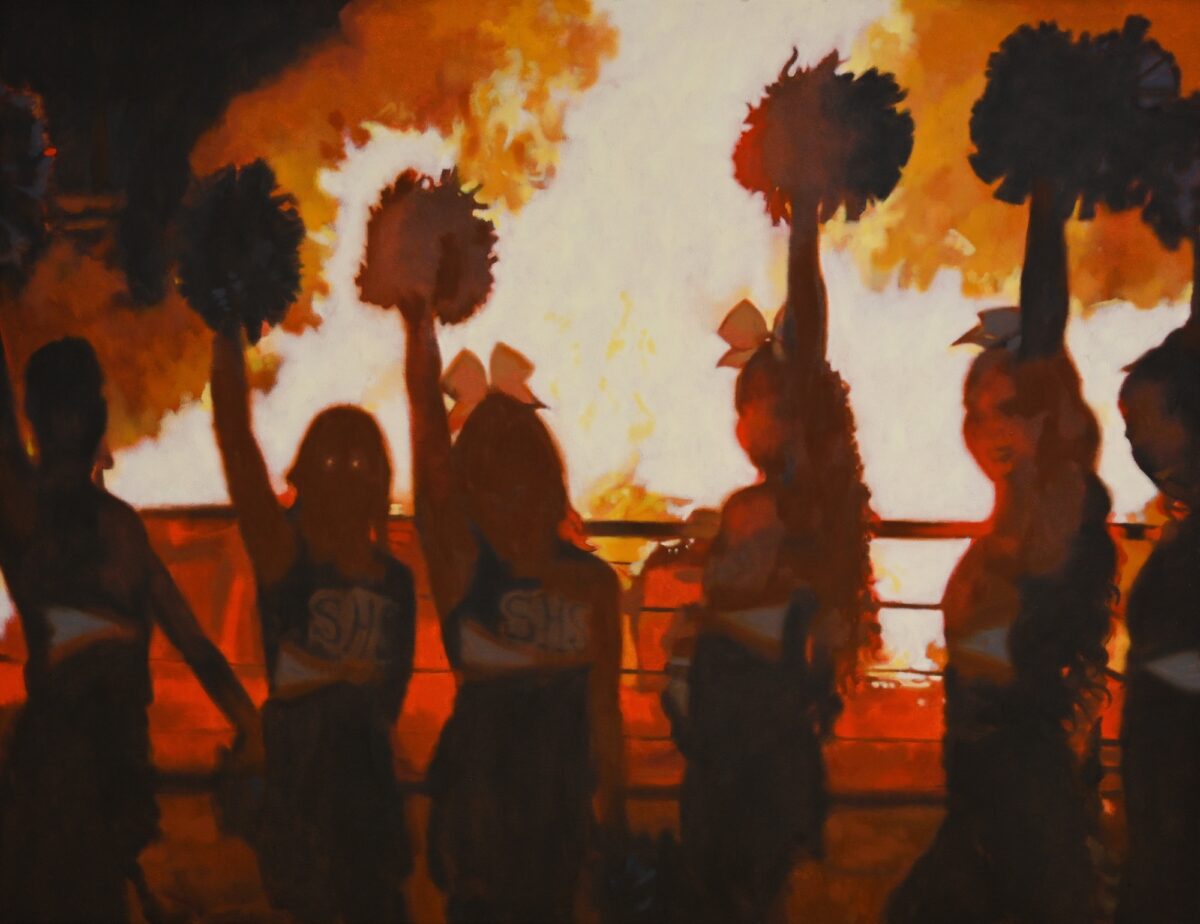
Some of the recent paintings are based on local newspaper photos, some are made up as I’m working, some are personal photos, and some are based on screenshots from homecoming vlogs. Some of them are several images mushed together to create this whole other universe. I guess a good example of that would be Curtainfall. That one is also specifically touching on rural spaces with the prairie burn, that in relation or in contrast to the pep-rallies, just kind of taking it a step further outside of the original space.
I am originally from a small rural town in the Midwest and I have been here my whole life, but I’ve never really felt like I was a part of that thing necessarily. I came back to it with a new perspective recently. I realized there was a lot of charged energy within Minnesota that I wasn’t really considering before, I guess, what are these little secrets that are within these small towns, thinking about that sort of potential energy, or the release of that.
I’m also really interested in duality (of images) or several things happening at the same time without the ability to separate them. I’m cutting away information to access that energy hidden away, if that makes sense.
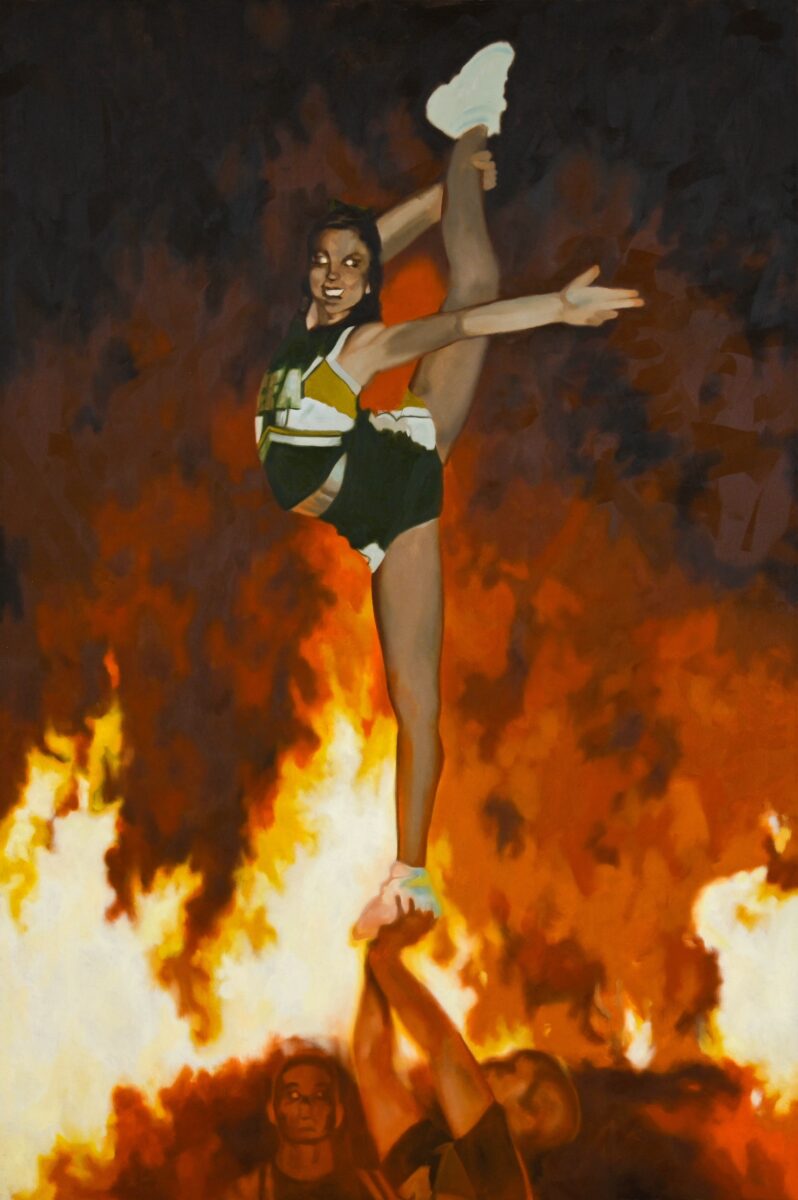
This is your first exhibition centered around a single theme. What have you learned through this latest series of work in terms of both your approach to painting and the overall sources of your inspiration?
I haven’t made a show that’s so visually cohesive or tight like this in a very long time. So thats kind of new to me and it’s kind of a relief in a way. I feel like I also I JUST finished it like I literally just wrapped up the last painting, so it’s kind of fresh to me still, so I might have further thoughts later, but it feels really nice to get it all out there in the open.
These are the largest paintings you’ve made to date, what were some of the logistical challenges and creating these paintings? Have you gained a new method of working?
I think the way that I am making the painting changes a little bit and I do think I just need more experience with that to get the two closer, but I think, yeah, just the process of actually painting it is more challenging than actually scaling up the image. Because they can’t be the same, it gives me flexibility as well in a way to learn new things about myself. Usually when I’m painting small, the first pass is done all in one sitting, so it just takes a little bit more strategic planning.
I’m really short and I have to stand on ladders to get to the top of the painting. Or crawling around on the ground–– goblin mode. I kind of like that about working large, I have to be very present as a whole body.
You frequently explore the tension between physical reality and symbolic or cultural representation, creating a duality of repulsion and attraction. How do you conceptualize the idea of ‘tension’ in your work
I want things to be super quiet sometimes, and I think that that versus something so extreme, like a spectacle, I think that the tension between those two things existing together can achieve that in some ways. And I hope that with this show I can do that just because having one painting from this sort of imagery, tangent, it’s always one or the other, but I think that them altogether can kind of create that tension within the space. But yeah, I have a difficult time deciding if the painting should be as quiet as possible or as loud as possible. And then also, again, with the removal of information, I think that that creates a lot of tension. It’s how little or how much can be included without screaming at people.
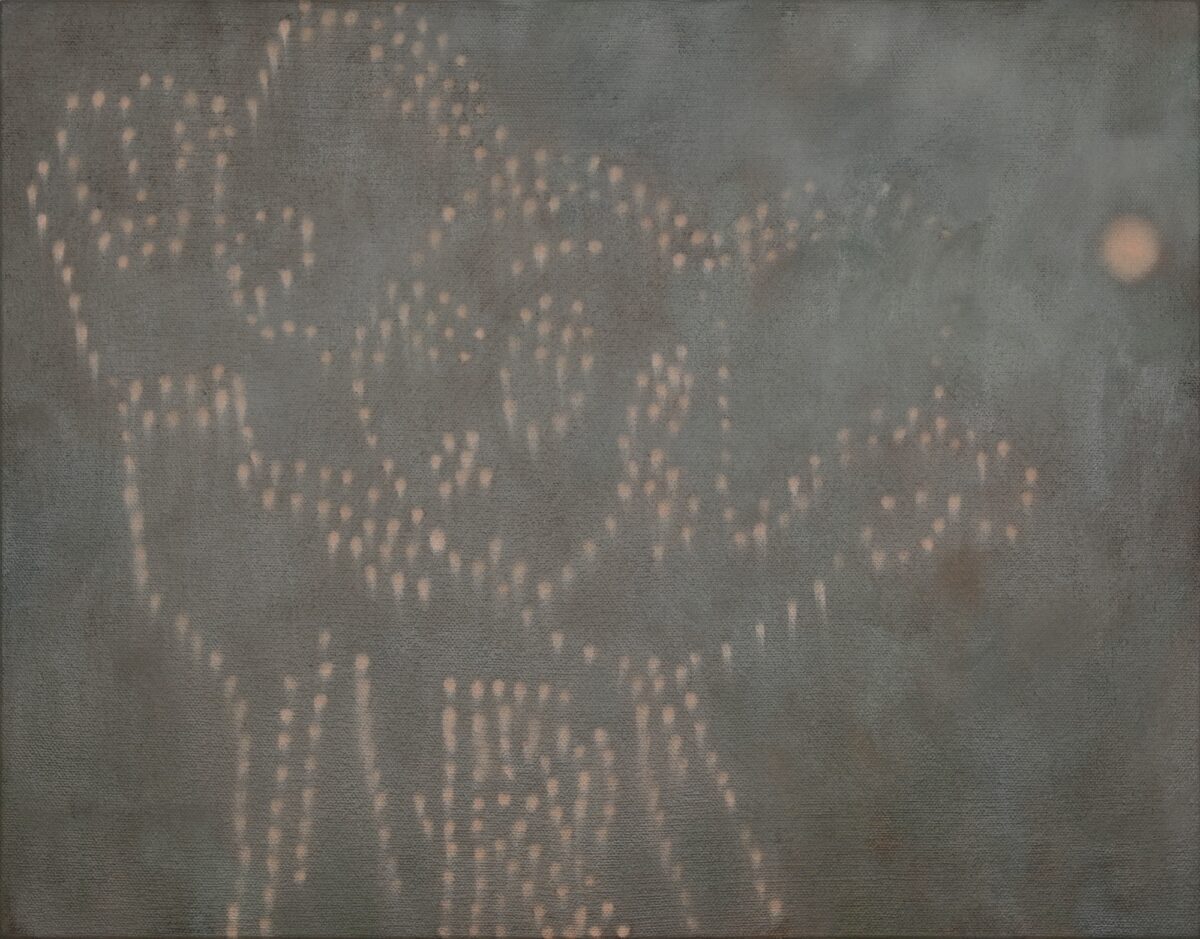
The spectacle is a recurring and powerful theme in your work. When navigating between the whisper, more subtle moments and the louder, more dramatic events within these subcultures, what informs your decision-making process? How do you choose which moments to amplify and which to leave more restrained?
There was one that I just did recently that is a painting of a drone light show titled Shooting Star Choreography. I feel like that’s a kind of whispering. There’s these drone light shows that are happening at these pep rallies above the bonfire, and I just find that sort of thing to be so perfect in every way possible, just because it’s so, it is just super loaded in a way. I find that the military crossing over into sports and wholesome get-togethers, and also with all the weirdo drone sightings, I think that is just so wild. I was like, oh, this is eerily perfect in this moment.
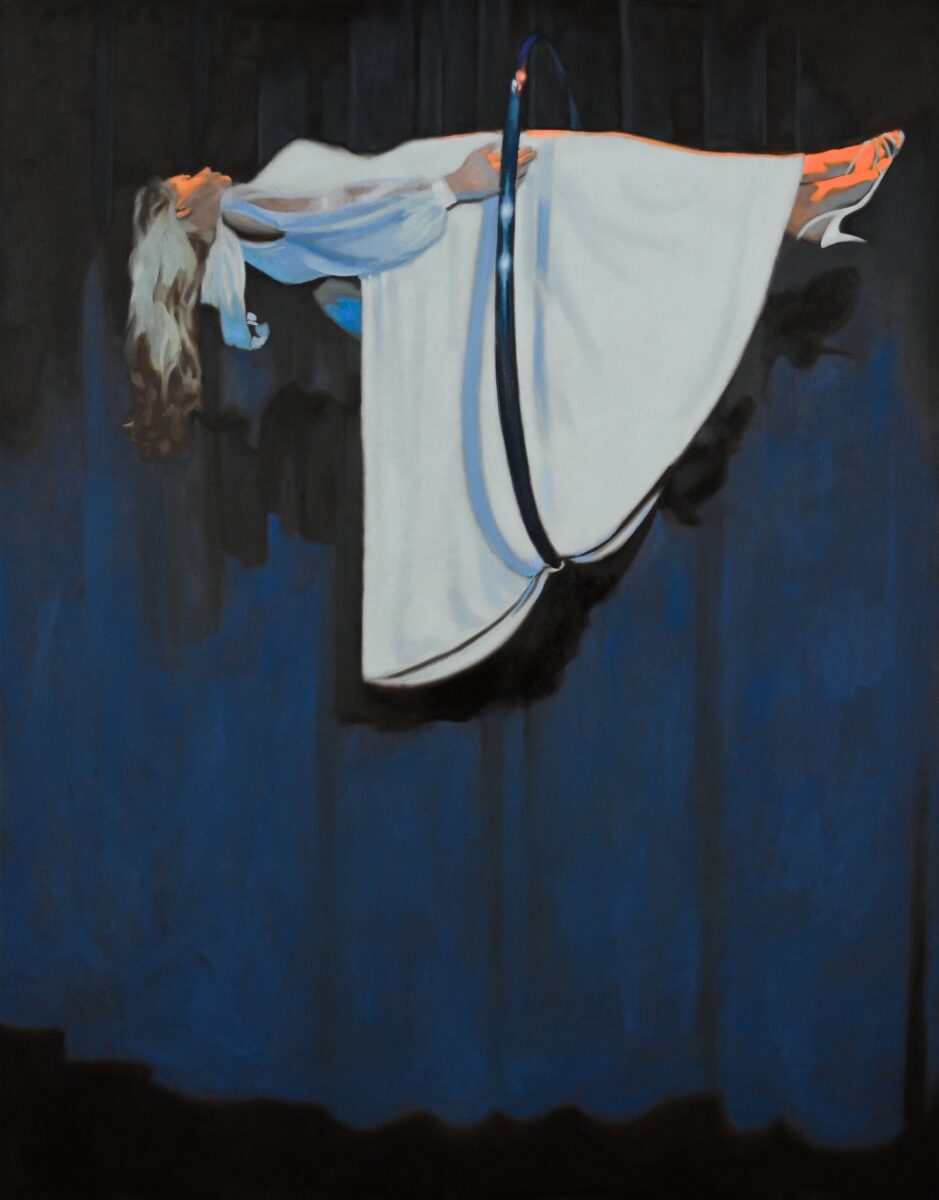
You work across a range of mediums, including sculpture, painting, and immersive installations. How do you determine which medium is best suited for a particular idea or concept? Is the choice of medium integral to the message you wish to convey? Are there many forms in which a message can be presented?
I don’t think painting does everything, obviously. I think it’s just something that I’ve been interested in recently, so yeah, I think I just have to switch the way I’m thinking about things. I think that the same things can be said in many different mediums. I think this (the cheerleader paintings) could also work as a sculpture in a way. I’m planning on making more sculpture work moving forward. When I went to grad school, I specifically stopped painting just because I felt like painting was becoming this very disconnected medium for me and I wanted to understand why I was even doing it, so for four or five years I just wasn’t painting at all, just making objects and sculptures. I recently came back to painting a year and a half ago. For me this feels like a reintroduction to the material. I felt like I was fighting the image or I was not connected to them in a way that was beneficial or meaningful. So now I’m in a brand new relationship with these things and I’m trying to figure out what that means. Some days I can feel myself drifting away again so we will see what that looks and feels like in the coming months. Change feels good.
In prevous exhibitions, you’ve use lighting, scent, and materials in various ways. How do you decide on these sensory elements, and what kind of emotional or psychological responses do you aim to evoke?
I think it goes in waves, honestly. I get a little just obsessed, I guess, with just surfaces and feeling, just and also sensorial restriction or withholding. Maybe that adds to the charge of the object.
I love shiny. But it can also be a warning sign in a way, I think like a siren or sirens, meaning more like the mermaid siren sort of way. Yeah, I like that kind of thing. There’s a fun book about the psychology or mixed meanings of shiny called Shiny Things by Leonard Diepeveen and Timothy van Laar.
I like thinking about duality in a way that’s like, you can’t really choose what you’re going to see, it’s more of a reactive response embedded in your body. Personal archive digging.
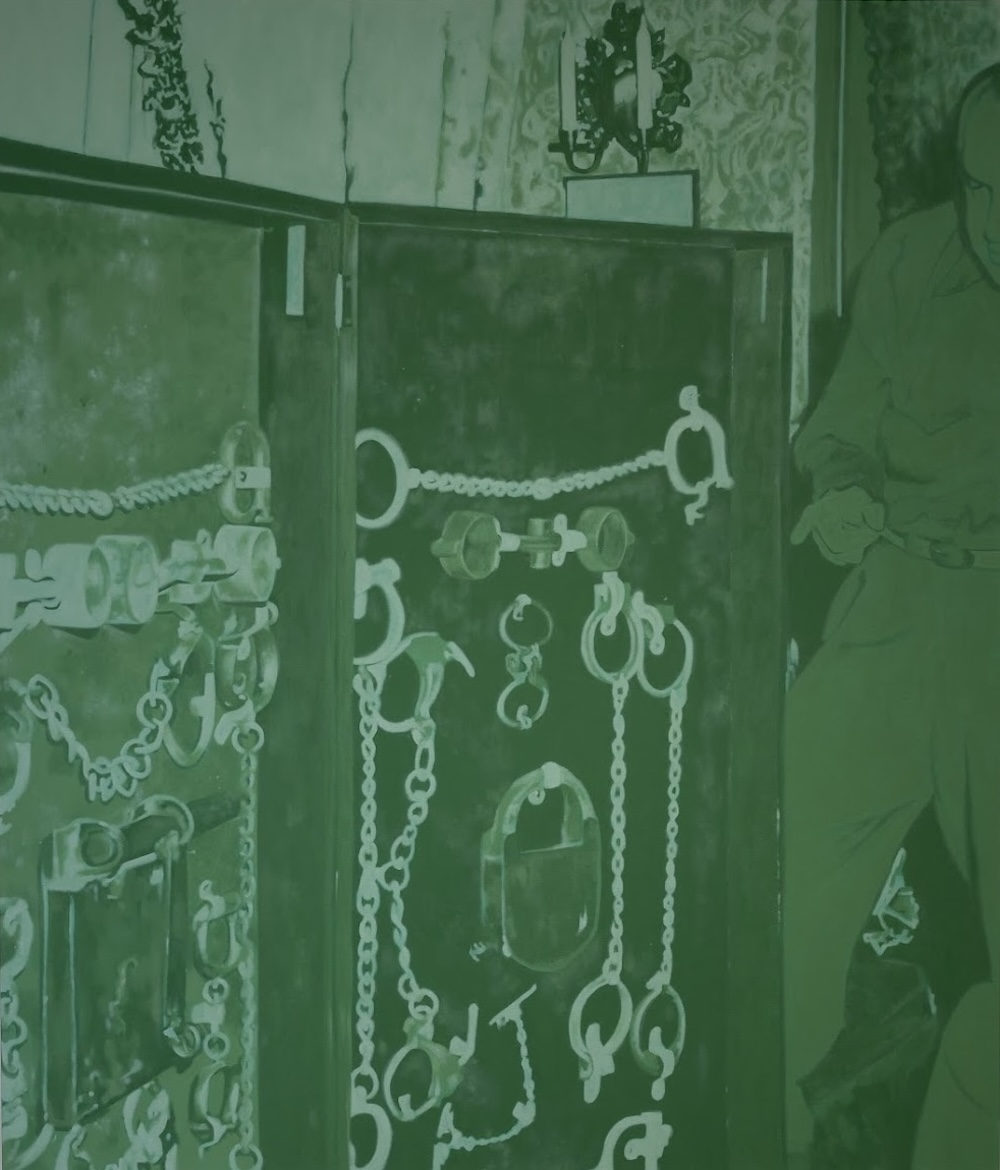
Your work often recontextualizes familiar objects and symbols. How do you source materials for your installations, and do the chosen materials carry specific connotations that are central to the meaning you want to explore?
I think about paintings and sculptures/objects in a very similar way. I usually give myself parameters to work with and against. I don’t necessarily have said parameters written down and they may change depending on the specific work. For example on a sculpture project I might only allow myself to look for materials on Facebook marketplace or on the side of the road. Those feel like archives in a way. I like the reuse of things, they’ve come pre-charged already, it gives me this energy to work with and to expand upon. I haven’t quite solved, and I’m not interested in solving, the connection between objects in images. I think it is, again, kind of a feeling. Mining the archive to see how I’m responding to things versus seeking something out. I think that that’s more interesting to me than having this specific thing or goal, I think that that makes it more interesting for myself. I’m always finding threads in my web crossing. Why make something if it’s not exciting?
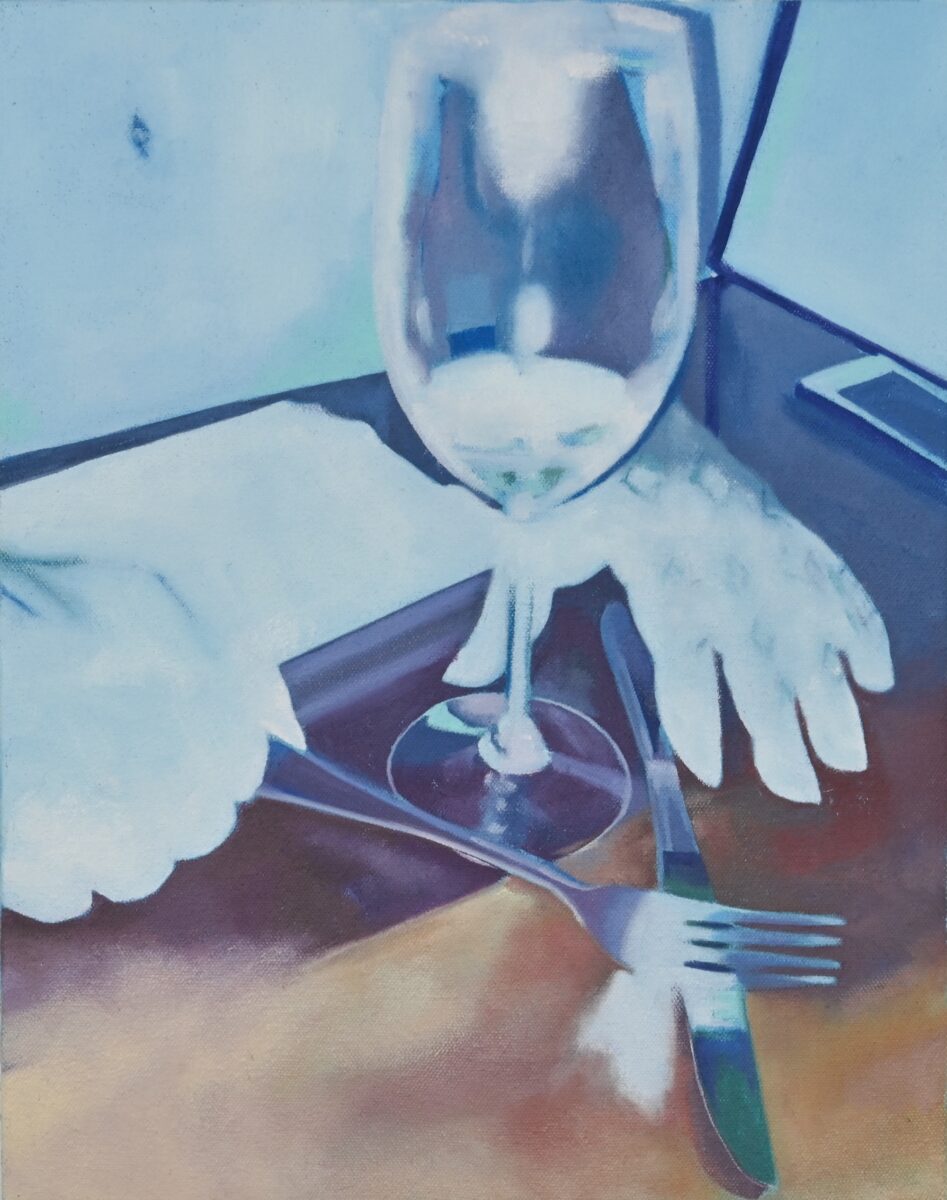
Psychoanalytic theory, particularly the concepts of the symbolic and the real, plays a central role in your work. How do you engage with these ideas when manipulating familiar imagery or symbols, and what does this distortion and blurring of meaning allow you to explore?
I’m interested in new possibilities. I guess taking away, or again, putting parameters on the way that people are experiencing information really puts me in a place of control, but also allows for things to come from that. I guess in a way I don’t really think about, okay I guess I do a little bit, I’m not so concerned with the viewer or the audience. If I take away enough information for myself that I don’t really recognize what is happening, I’ve kind of gotten it to a place where some of those things can happen or this sort of re-understanding of ambiguity. As for these pep-rally cheerleaders, the bonfire portion of it is born out of tradition to welcome back alumni to the school and the cheerleaders are the leaders of this celebration. Stating that anything is an ‘American tradition’ makes me so skeptical of that thing not being evil at its roots or to some degree. So yeah, I think just isolating that tradition is thought provoking. A reintroduction to common/normal information seems to be good just generally speaking.
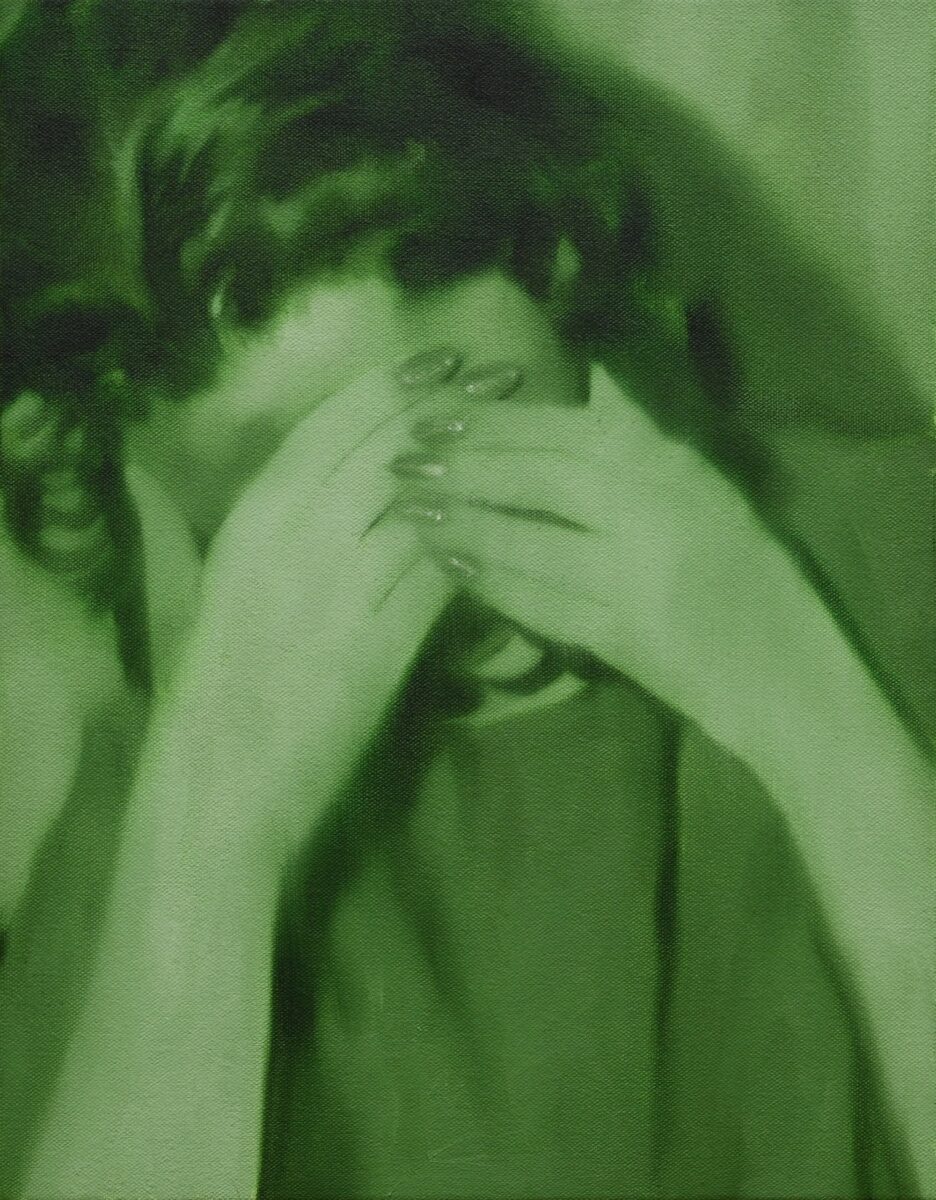
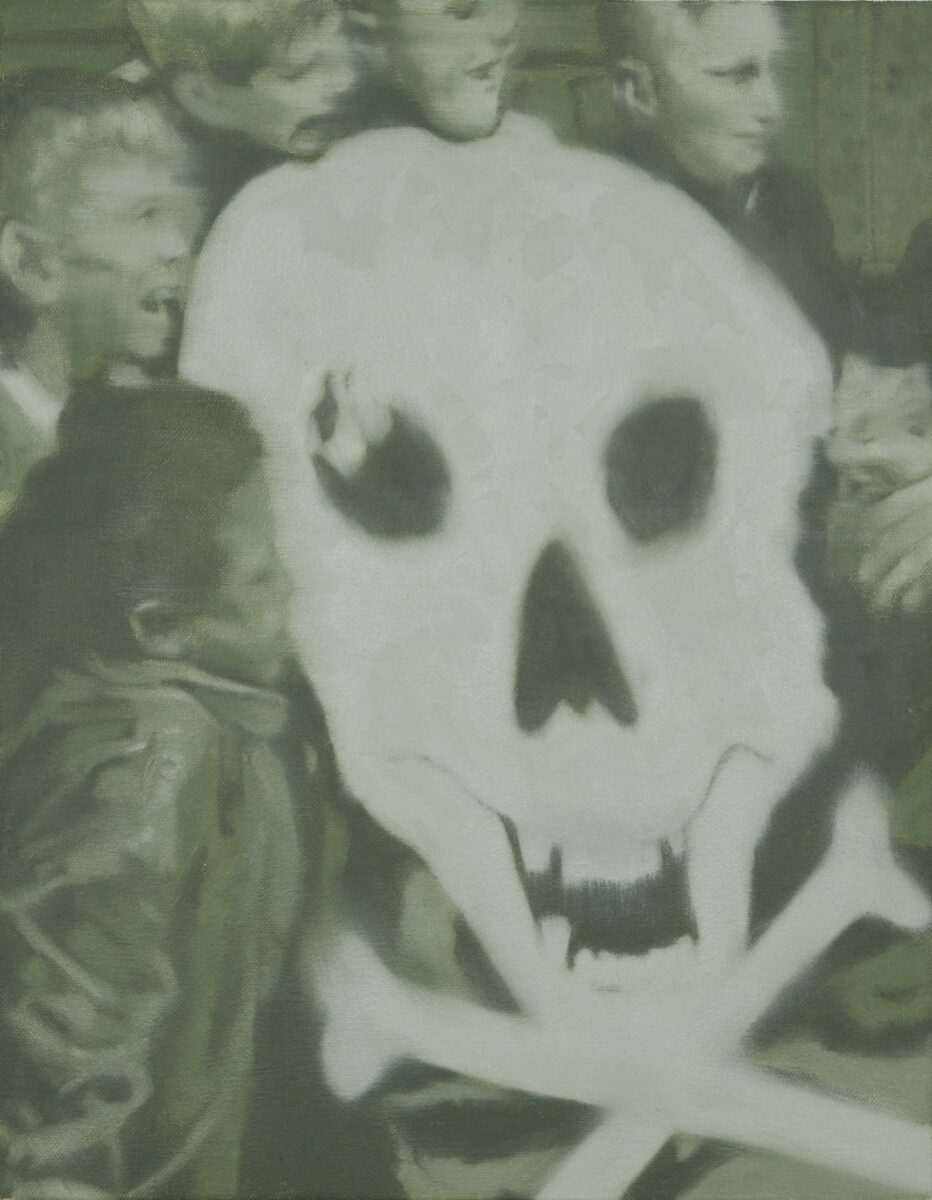
You’ve clearly worked very hard on this latest series. Whats next for you?
Show wise, I am doing a few group shows and then I’ll do a two person show with Lee Noble at Material Room this spring and another two person show with Cameron Downey in the fall will be at Hair + Nails in Minneapolis. I don’t think there’ll be any paintings in the second one, so that’ll be a fun project to dive into .
I’ve been collecting stuff for the past few years. I have a bunch of children’s bouncy horses in the basement, and I have a scythe and some vintage fencing swords. Either gifted to me or I found them on Facebook marketplace. We will see where that takes me.
Oh! Also, I have to mention my partner and I run a gallery space in the twin cities called Night Club and we just got the keys to our new store front in St. Paul on March 1st so we will start programming there very soon. We’ve been getting together a great list of artists from all over for this coming year.
To learn more about Emma Beatrez, follow her on Instagram and visit her website at emmabeatrez.com
